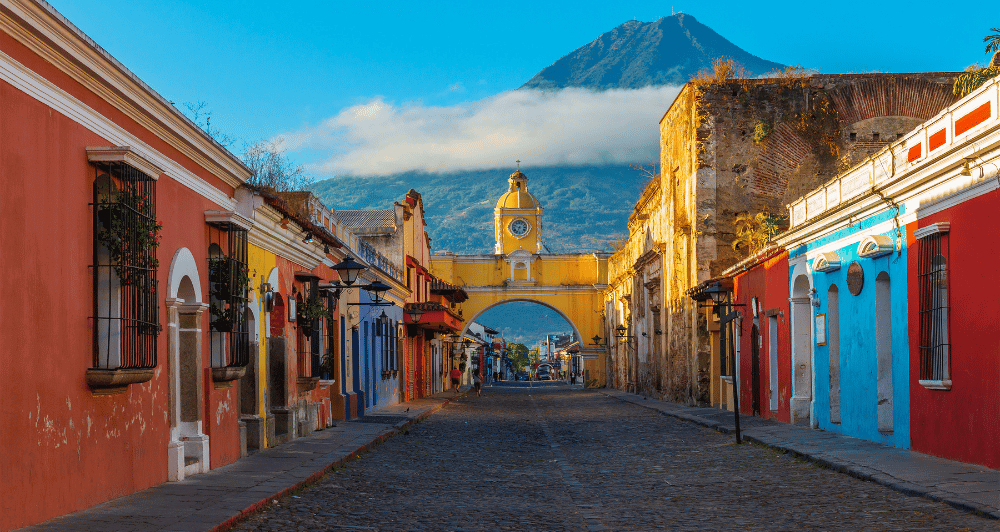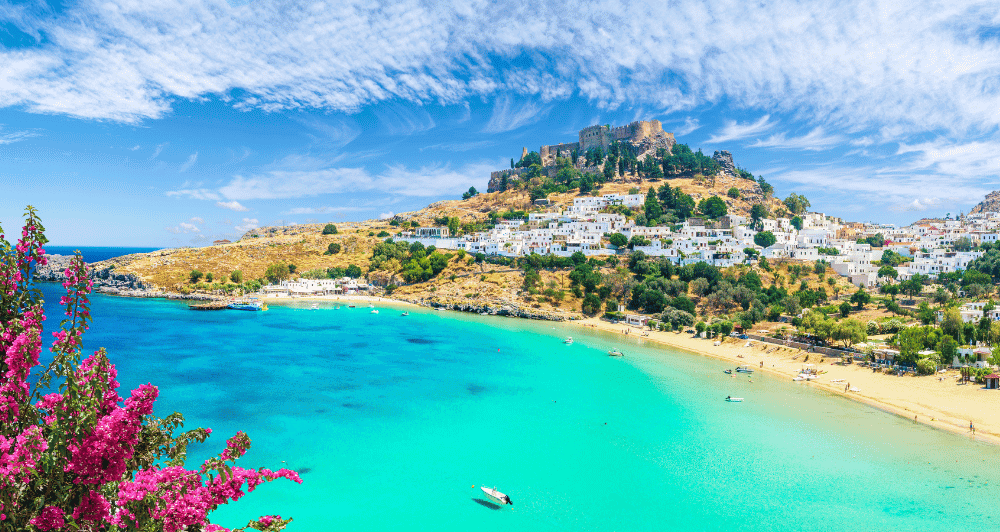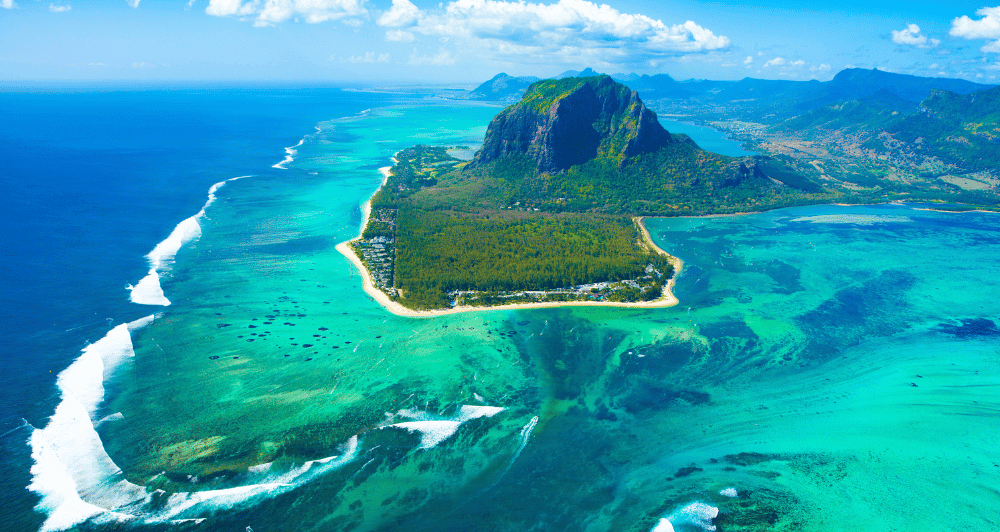Where to Go & When | Family Holidays
Table of Contents
- February Half Term
- Easter Half Term
- May Half Term
- The Summer Holidays
- October Half Term
- The Christmas Break
- FAQs
- When is the Best Time to go to the Maldives?
- When is the Best Time to go to Mauritius?
- When is the Best Time to go to the Seychelles?
- When is the Best Time to go to Dubai?
- When is the Best Time to go to Abu Dhabi?
- When is the Best Time to go to the Caribbean?
- When is the Best Time to go to Greece?
- When is the Best Time to go to Spain?
- When is the Best Time to go to the Far East?
Choosing the perfect time to take your family on holiday can make all the difference. Whether you're looking for winter sun, Easter escapes, or summer adventures, knowing where to go & when ensures you’ll find the best weather, fewer crowds, and experiences tailored to your family’s needs.
From the tropical shores of the Maldives in February half-term to Greece’s sun-drenched islands in summer, this Destinology guide breaks down the best destinations for every school holiday. Read on and we’ll help you find the perfect place at the perfect time.

February Half Term
Maldives
The Maldives’ dry season is from November to April – low humidity, clear skies, little to no rain, and average temperatures of around 29°C. Visibility for diving and snorkelling is best, especially in the eastern atolls.
St. Lucia
Expect hot days with warm evenings, with daily average temperatures of 24 degrees, perfect for sunny days that aren’t too hot for little ones.
Dubai
February in Dubai is pleasant and mild, and daytime temperatures range from 22°C to 26°C. There’s a low chance of rain, humidity levels are comfortable for the whole family, and it’s a great time to explore the city’s attractions.
Thailand
February is one of the very best times to visit the southern regions of Thailand, particularly those in the Andaman Sea. Phuket, Koh Lanta, Krabi and the Phi Phi Islands enjoy warm temperatures, minimal rainfall, calm and clear seas perfect for island hopping and cruises.

Easter Half Term
Spain
Easter can fall on any date between 22nd March and 25th April, so spending it in Spain does vary on the month. In March, temperatures range from 16°C to 20°C, meaning you can still sunbathe while also enjoying walks and activities. The sea may be a tad chilly for swimming in March, but visiting at this time is still incredibly enjoyable – it’s not too hot for children, and the crowds are less.
Spain in April is when the region begins to warm up, and temperatures increase to 22°C. Warm areas at this time of year include the Malaga and Marbella, Seville and Granada, and the Balearic and Canary Islands – destinations like Majorca, Ibiza, and Tenerife.
Antigua
Antigua is a wonderful choice for March and April – average temperatures sit at around 28/29°C, decreasing to around 24°C when the sun sets. It’s generally a dry month, but any showers are short and refreshing. The sea is balmy, perfect for swimming, and the humidity isn’t too high, so it’s excellent for little ones. The island is known for its trade winds but, like the showers, they help to keep the temperature down.
St. Lucia
Warm, dry, and with plenty of sunshine. St. Lucia’s dry season runs from December to April, but April is technically considered the shoulder season, so it’s the perfect choice for an Easter half term break. Rainfall is minimal, sun is plenty, and the temperature sees highs of 30°C and lows of 24°C.
Dubai
Dubai in April is the perfect time to visit the city before the peak summer heat arrives. The sea is around 25°C, perfect for swimming and water sports, you’ll enjoy around 10 hours of daylight, minimal rainfall, and average daily highs of 33°C, lows of 21°C. It’s a great time for desert safaris, boat trips, and beach days, but remember that while it’s not the peak of summer, the warmth is on its way, so humidity is on the up.

May Half Term
Greece
May is an excellent time to visit Greece, as the weather is warming up yet the crowds of peak summer have yet to arrive. Expect temperatures between 22°C and 26°C, with warm seas in the southern islands such as Crete and Rhodes. Historical sites like the Acropolis and Knossos are more pleasant for children to explore without the intense summer heat.
Thailand
May marks the beginning of the green season in Thailand, but destinations like Koh Samui remain sunny with minimal rain. Expect fewer crowds, excellent hotel deals, and lush landscapes in the northern regions like Chiang Mai.
South Africa
May is autumn in South Africa, meaning mild temperatures and fewer tourists. It’s a fantastic time for a safari in Kruger National Park as wildlife spotting is still excellent and the temperatures are comfortable. Cape Town enjoys clear days with temperatures around 20°C, ideal for hiking Table Mountain or exploring the Winelands.
Abu Dhabi
Similar to Dubai, Abu Dhabi sits at a pleasant temperature in May, with highs of 36°C but low humidity. It’s a fantastic time to explore cultural sites like the Sheikh Zayed Grand Mosque or enjoy the luxury resorts of Saadiyat Island.

The Summer Holidays
Greece
With endless sunshine and warm seas, Greece is an unbeatable choice for a summer holiday. Santorini, Mykonos, Crete, Corfu and Halkidiki are among the top destinations, home to beautiful beaches and some of the world’s best luxury family resorts, like Ikos and Sani.
Sri Lanka
The east coast of Sri Lanka - destinations like Arugam Bay, Trincomalee, and Pigeon Island - enjoys sunny, dry weather in August. There are plenty of golden beaches to explore, and wildlife safaris in Yala National Park and cultural explorations in Kandy are also excellent at this time.
Vietnam
August is a great time to visit central Vietnam, including Hoi An and Da Nang, where warm temperatures and low rainfall make for perfect beach days and cultural excursions. Adventurous children will love to try new foods and explore old temples.
Algarve
Portugal’s Algarve sees sunny weather, golden beaches, and a cooling Atlantic breeze in the summer – the perfect holiday for all the family without being too hot. It’s a fantastic choice for anyone looking for a mix of adventure and relaxation.
Seychelles
August in the Seychelles means dry and sunny weather with pleasant breezes, making it a perfect time for island hopping and snorkelling.
Mauritius
Warm temperatures and low humidity are the hallmarks of Mauritian weather in the summer, as averages range in July from 18°C to 23°C. Coastal areas tend to be a little warmer and can reach up to 25°C during the day.

October Half Term
Turkey
The heat of Turkey can be too much even for adults in the peak of the British summer, but in September and October it begins to cool slightly. If you’re looking for a warm escape for the first half term of the new school year, destinations like Antalya can be perfect for a mix of beach and cultural exploration, as temperatures sit at around 26°C.
Mauritius
October in Mauritius means the end of winter and the beginning of summer. The west and northwest coasts of the island are recommended, as they’re a little more sheltered from trade winds, making them even more warm and dry. Sea temperatures are on the up and the average land high is 27ºC, dropping to a very pleasant 18ºC at night.
Greece
Greece is a great destination to visit in October, as there’s still a high chance of beautifully warm and sunny weather. Southern islands like Crete, Santorini and Mykonos are the warmest with temperatures reaching 25°C or higher.
Dubai
October is a transitional month for Dubai – the end of the extreme heat of summer, and the perfect time for outdoor exploration. Days are warm and sunny, reaching highs of 35°C, while nights cool to 23°C. Expect 10 hours of daylight, warm seas, and a low chance of rain. The high season begins in November, so October is a great time to visit before prices hike up.
Maldives
The Maldives is reaching the end of the wet season in October, so while humidity is still a little high and showers can be expected, it’s more bearable and the rain can be both fleeting and refreshing. Long days of sunshine are complemented by temperatures of around 27°C to 29°C

The Christmas Break
Maldives
December is traditionally one of the best times to visit the Maldives. Days are long and warm, with a chance of mild sea breezes and mid-month showers – though these are usually fleeting and offer a little break from highs of 29°C. The sea is balmy, making it ideal for snorkelling and water sports. It’s not your usual Christmas, but it will be incredible.
The Caribbean
St. Lucia’s dry season runs from December to May – sunny and dry conditions, low humidity, and temperatures of around 24°C-29°C. December days are usually hot, so swap jumpers for light layers. The Bahamas, Barbados, and Jamaica are equally popular at this time of year.
Dubai
December in Dubai isn’t nearly as hot as the peak summer months, but for anyone travelling with little ones in tow, this is a good thing. Expect temperatures of 15°C to 26°C in the day which drop to around 15°C to 20°C in the evening. While Dubai is predominantly a Islamic country, luxury hotels and malls decorate spectacularly for Christmas, so there’ll be plenty to get you into the festive spirit.
Cambodia
Visit the southern coast of Cambodia towards the end of the calendar year to enjoy dry, warm and sunny days - the perfect conditions for exploring historical sites like Angkor in Siem Reap, the Killing Fields, and beautiful temples.

FAQs
When is the Best Time to go to the Maldives?
With shifting weather patterns, the Maldives is becoming a year-round destination, offering beautiful escapes beyond what was the traditional peak season.
November - April: The classic dry season with little rain, plenty of sunshine, and excellent visibility for snorkelling and diving. Expect warm, calm waters and idyllic conditions.
May - July: An emerging favourite – Destinology experts have visited during these months and enjoyed spectacular weather. Fewer crowds, lower prices, and more availability make this an appealing time to visit.
Year-Round: As a tropical destination, rain showers can occur at any time but are usually short-lived, quickly giving way to sunshine.
We have blogs covering every single month in the Maldives. Read them here.
When is the Best Time to go to Mauritius?
With just two seasons - summer and winter - Mauritius offers year-round appeal, but some months stand out for the best conditions:
April - June & September - October: The ideal time to visit with warm, dry weather, fewer crowds, and temperatures in the mid-20s°C. Perfect for beach days, outdoor adventures, and exploring the island.
July - August: A popular time for visitors, with slightly cooler temperatures and steady trade winds – great for kitesurfing and wind-based activities.
November - April: The island’s wet season brings higher humidity and occasional heavy showers. Cyclone season runs from November to May – though direct hits are rare, it’s important to bear this in mind.
When is the Best Time to go to the Seychelles?
This region of the world is typically a year-round paradise, but the best time to visit the Seychelles does depend on what you’re looking for:
April - May & October - November: The sweet spot. Warm, calm, and with crystal-clear waters perfect for snorkelling and diving. Ideal for island-hopping and relaxation.
June - September: The driest season, with cooling trade winds. This time of year is great for hiking, windsurfing, and sailing, though some beaches may have stronger waves.
December - March: Warmer, more humid, with short tropical showers. The sea remains warm, and it’s prime time for spotting nesting hawksbill turtles.
When is the Best Time to go to Dubai?
Dubai is a year-round destination, but temperatures vary dramatically, making some months more comfortable than others – especially if you’re travelling with children.
November - March: The best time to visit with warm, pleasant weather (24–30°C), perfect for exploring the city, beaches, and desert. This is peak season, so expect more visitors.
April - May & September - October: Transition months with rising temperatures (30–38°C). It’s hot but manageable, and you’ll find fewer crowds and better value at hotels.
June - August: This is the height of summer, so temperatures can exceed 40°C. While outdoor activities are limited, Dubai’s luxury hotels, malls, and attractions are fully air-conditioned, making it possible to enjoy a city break in the summer.
Read our blog: Do Something Different in Dubai
When is the Best Time to go to Abu Dhabi?
Abu Dhabi shares Dubai’s desert climate but offers a slightly calmer alternative with beautiful beaches, cultural attractions, and luxury resorts.
November - March: The best months to visit, with warm but comfortable temperatures (24–30°C) and little humidity – ideal for sightseeing, beach days, and desert safaris.
April - May & September - October: Warmer but still enjoyable (30–38°C), with lower hotel rates and fewer tourists. Perfect for poolside relaxation and water sports.
June - August: Extremely hot (40°C+), but with Abu Dhabi’s ultra-luxurious indoor attractions, including Louvre Abu Dhabi, there’s still plenty to do.
Looking for ideas of things to do in Abu Dhabi? Read our Top 10 activities blog here.
When is the Best Time to go to the Caribbean?
With warm temperatures year-round, the best time to visit the Caribbean depends on the balance between sunshine, crowds, and potential storms:
December - April: The prime season, with warm, dry weather and little humidity. Perfect for sun-seekers.
Barbados & Antigua: Peak season with beautiful conditions, ideal for beach lovers and water sports.
St. Lucia: Dry season, perfect for exploring rainforests and the iconic Pitons.
May - June: A great time to visit with fewer crowds, lower prices, and warm temperatures, though occasional showers occur.
July - November: The wet season, with higher humidity and a chance of storms, though islands like Barbados and St. Lucia are outside of the main hurricane belt and typically only experience short bursts of rain.
When is the Best Time to go to Greece?
Greece enjoys a Mediterranean climate, with different islands being appealing at different times of the year:
May - June & September - October: The best months to visit with warm weather (22–28°C), fewer crowds, and perfect sea temperatures. Ideal for island-hopping and cultural explorations.
Santorini & Mykonos: Less peak summer crowds with lovely weather.
Crete & Rhodes: The warmest islands with long summers and excellent beaches.
Corfu & Halkidiki: Lush and green, with perfect hiking conditions.
July - August: High season with hot temperatures (30°C+) and busy beaches. Best for nightlife and lively resorts.
November - April: The off-season – cooler temperatures, quieter islands, and a more local feel. This time is ideal for cultural city breaks in Athens or Thessaloniki.
Find out which Ikos, Sani, or Grecotel resort is the best for you in our blogs:
Which Ikos Resort is Best For Me?
Which Sani Resort is Best For Me?
Which Grecotel Hotel is Best For Me?
When is the Best Time to go to Spain?
Spain’s diverse climate means the best time to visit varies by region:
April - June & September - October: The ideal months. Temperatures are warm but not overwhelming (22–28°C) and there are fewer crowds.
Andalusia (Seville, Granada, Malaga): Best for exploring historic cities with pleasant spring and autumn temperatures.
Balearic Islands (Majorca, Ibiza, Menorca): Beautiful beaches and warm seas without the summer rush.
Canary Islands (Tenerife, Lanzarote, Gran Canaria): A great year-round option with mild temperatures – even in winter.
July - August: Hot and busy, especially inland where temperatures can exceed 35°C. Best for coastal stays and beach holidays.
November - March: Cooler and quieter but still pleasant for city breaks in Madrid, Barcelona, and Seville, and mild beach weather in the Canary Islands.
When is the Best Time to go to the Far East?
The best travel seasons in the Far East vary by country.
November - April: The prime time for most destinations, with dry, warm weather and comfortable humidity.
Thailand: Ideal for the south, including Phuket, Krabi, and Koh Samui, with sunny skies and calm seas.
Vietnam: Best for the south (Ho Chi Minh City, Phu Quoc) and central regions (Hoi An, Da Nang). Hanoi and the north can be cooler.
Cambodia: Dry season with perfect conditions for exploring Angkor Wat and the Mekong River.
May–June & September–October: Shoulder seasons, offering fewer crowds and lower prices. Occasional rain showers refresh the landscape.
Thailand: The Gulf islands (Koh Samui, Koh Phangan) see better weather than the Andaman coast.
Vietnam: North Vietnam (Hanoi, Halong Bay) is at its best, while central regions experience occasional rain.
Cambodia: Rainy spells, but landscapes are lush and waterfalls are at their best.
July–August: The green season, with occasional heavy showers but plenty of sunshine in between.
Thailand: Rainy season, but the Gulf islands remain drier.
Vietnam: Hot and humid, with heavy rains in central regions.
Cambodia: Fewer tourists and vibrant green landscapes, but travel in rural areas can be tricky.
Hopefully this blog has helped you decide where to go & when with your family. If you have any questions, our team of Personal Travel Concierges are on hand to help you plan your next getaway. View our school holiday travel deals below and call to book today.
Explore Our School Holiday Travel Deals










